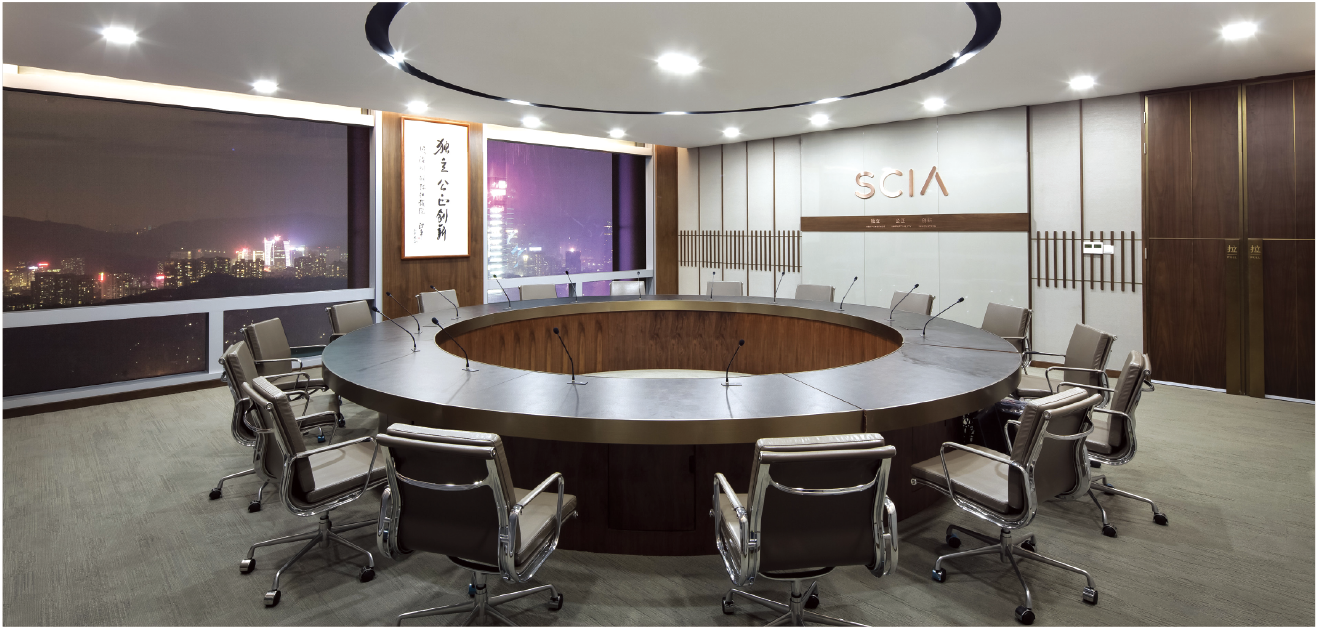
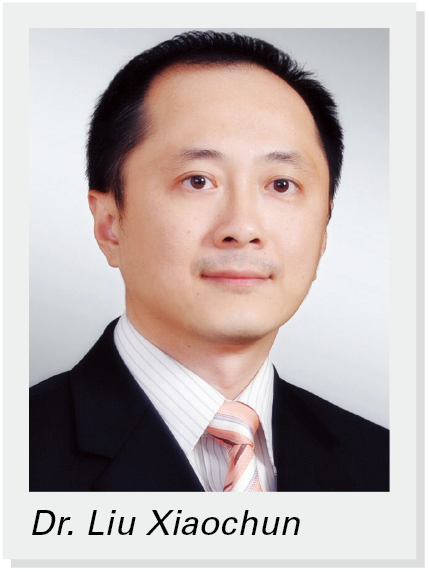
By Dr. Liu Xiaochun, president of Shenzhen Court of International Arbitration
The history of China’s opening-up policy and the internationalisation process of arbitration in Shenzhen, as well as the future of the merged arbitration institutions.
South China International Economic and Trade Arbitration Commission (Shenzhen Court of International Arbitration) and Shenzhen Arbitration Commission have been merged into Shenzhen Court of International Arbitration (Shenzhen Arbitration Commission) as of December 25, 2017. The merger of the arbitration institutions in Shenzhen SEZ has attracted wide attention of the legal profession as well as the industrial and commercial society from both China and the world.
As for the background, I will mainly share the four organisational innovations of the internationalisation and modernisation of China’s arbitration in Shenzhen SEZ from the perspective of China’s reform and opening-up and the construction of the special economic zone (SEZ). As for the future, I will mainly focus on where the arbitration institution is going after the merger.
BACKGROUND OF THE MERGER OF ARBITRATION INSTITUTIONS IN SHENZHEN SEZ
The year 2018 witnesses the 40th anniversary of China’s reform and opening-up, the 38th anniversary of Shenzhen SEZ. It is also the 35th anniversary of the SCIA. To recall the history of the past four decades, we need to look at Shenzhen, the history of Shenzhen as well as the arbitration from the outside of them.
Generally speaking, all the four organisational innovations of China’s arbitration in Shenzhen SEZ are symbolic milestones of changes and reforms.
 The first organisational innovation
The first organisational innovation
The first organisational innovation of China’s arbitration in Shenzhen SEZ was commenced at the beginning of China’s reform and opening-up, ie the spring of 1982. After more than one year’s exploration and improvement, the arbitration institution of Shenzhen SEZ was formally established on April 19, 1983. It is the first arbitration institution in the Guangdong-Hong Kong-Macau region and the first arbitration institution established by a government of province and municipality level in China. It is also the first arbitration institution of China that recruits foreign professionals as its panel arbitrators and the first arbitration institution of mainland China whose arbitral award was enforced abroad pursuant to the New York Convention.
The second organisational innovation
The second organisational innovation of China’s arbitration in Shenzhen SEZ occurred in 1995. The Arbitration Law of the People’s Republic of China was issued in 1994 and formally entered into force in 1995. As one of the seven pilot cities throughout the country, Shenzhen established Shenzhen Arbitration Commission by reorganising the administrative arbitration bodies attached to the relevant administrative authorities like the administration for industry and commerce, the land bureau, and the science and technology authority, etc. whose arbitration awards were not final. This played a leading role among the newly-established domestic arbitration institutions in China.
The third organisational innovation
The third organisational innovation of China’s arbitration in Shenzhen SEZ was in 2012. The administrative system and operational mechanism of South China International Economic and Trade Arbitration Commission (Shenzhen Court of International Arbitration) (hereinafter the “SCIA”) has experienced significant changes. Shenzhen SEZ adopted the Regulations on Shenzhen Court of International Arbitration (for Trial Implementation), and introduced the mode of statutory body by prescribing that the SCIA shall establish the Council-centred corporate governance structure. This was the first time to prescribe the governance structure of an arbitration institution through a special regulation, which indicated the confidence and determination of Shenzhen SEZ to enhance the credibility of China’s arbitration and improved the expectation of the parties about the impartiality and independence of the China’s arbitration in Shenzhen SEZ.
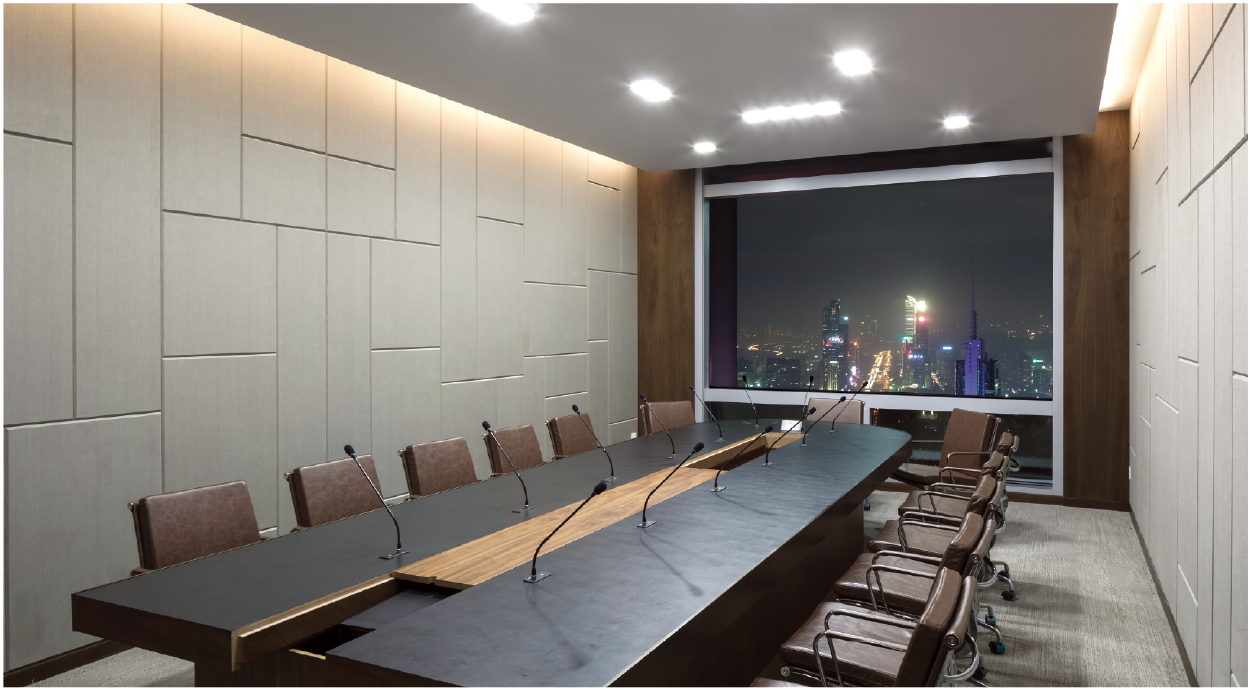
The fourth organisational innovation
The fourth organisational innovation of China’s arbitration in Shenzhen SEZ occurred on December 25, 2017, when South China International Economic and Trade Arbitration Commission (Shenzhen Court of International Arbitration) and Shenzhen Arbitration Commission, both of which were leading arbitration institutions in China, were merged into Shenzhen Court of International Arbitration (Shenzhen Arbitration Commission) (hereinafter the “SCIA”). The merger of permanent arbitration institutions was unprecedented not only in China but throughout the whole world — therefore we have no precedents to learn from. The merger of the two arbitration institutions aimed at establishing the commercial environment that is more internationalisation-oriented, of greater global influence and impartiality, so as to indicate the determination of Shenzhen SEZ to “further promote the reform and opening-up”.
The above is a general description of the historical background of the merger of the two leading arbitration institutions in Shenzhen SEZ. When we take a look at this great background, we need to look at Shenzhen and its history from the outside. After the development in the past four decades, we have now reached a new starting point.
FUTURE OF THE ARBITRATION INSTITUTION IN SHENZHEN SEZ AFTER THE MERGER
After the merger of the two arbitration institutions, what the public care about may be classified into the following five issues:
Vision and mission of development
In the past four decades, both the world economy and the economy of China have experienced great changes, and the total trend is that China is more and more involved in the globalisation of economy. In this process, the vision of development of the SCIA has also experienced some changes and adjustments, and the total trend is to be more modernised and internationalisation-oriented.
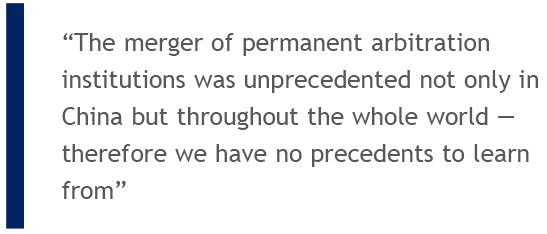 Without a common mission, the merger will not be successful. After the merger of the two arbitration institutions, the Council of the SCIA has determined the new vision of development through deliberation as “take root in Shenzhen SEZ, and cooperate with Hong Kong and Macau, so as to establish a world-class international arbitration institution”. It is to satisfy the market demand in the new era of China’s reform and opening-up, because in the background of Belt-and-Road initiative, there will be more and more Chinese enterprises “going global” and more and more foreign enterprises “coming in”. Therefore, the arbitration institution of Shenzhen SEZ should emulate the world-class arbitration institutions, actively satisfy the market demand for globalisation and promote the socio-economic development.
Without a common mission, the merger will not be successful. After the merger of the two arbitration institutions, the Council of the SCIA has determined the new vision of development through deliberation as “take root in Shenzhen SEZ, and cooperate with Hong Kong and Macau, so as to establish a world-class international arbitration institution”. It is to satisfy the market demand in the new era of China’s reform and opening-up, because in the background of Belt-and-Road initiative, there will be more and more Chinese enterprises “going global” and more and more foreign enterprises “coming in”. Therefore, the arbitration institution of Shenzhen SEZ should emulate the world-class arbitration institutions, actively satisfy the market demand for globalisation and promote the socio-economic development.
As we all know, the arbitral jurisdiction arises from the arbitration agreement between the parties; if there is not an arbitration agreement between the parties, there will not be any arbitral jurisdiction. We must ponder over the vision and mission of the SCIA from the perspective of the purpose of arbitration. What is the purpose of arbitration, and why an arbitration institution should develop? I think it will not be for the arbitration institution itself. It is due to the demand of market development and the development of enterprises. If an arbitration institution cannot satisfy the demand of enterprises, the demand of market and the demand of social development, it will be abandoned by the market in the end. On basis of this notion, the arbitration institution will have an even firmer mission after the merger, and our vision will also be more forward-looking.
Governance mechanism
The SCIA’s governance mechanism will not change after the merger, because the parties’ anxiety about the protectionism of local authority, the internal control and the interference of administrative authority can be eliminated only by the separation and balance among the decision-making, the administration and the supervision, so that the arbitration institution will develop in the long run and the arbitration system will maintain its vitality. This is also the basic system for enhancing the credibility of arbitration.
After the merger, the arbitration institution will continue to operate pursuant to the regulation issued by Shenzhen SEZ in 2012 on the statutory governance structure of the SCIA. The 13 Council members appointed in May 2017 will not be changed, and the statutory duties of the Council still remain the same, including significant decision-making, supervision on the administration and integrity of the arbitrators.

Route of development
The economy of China grows rapidly; many disputes will be resolved by arbitration institutions. At present, there are about 250 arbitration institutions throughout China and each has its own specific situations and route of development, and they are in the process of changes. The SCIA will discuss at the Council meeting whether its route of development will change from high-speed development to high-quality development. Although the two arbitration institutions ranked No. 5 and No. 6 in China by the total amount in dispute before the merger; however, these indexes are not very important, and it does not matter even if they decline to No. 10 or even No. 20. The main purpose of the merger of two arbitration institutions in Shenzhen SEZ is to have a stronger brand and better quality, rather than to become bigger quantitatively. To secure high quality, we have proposed the following route of development: stretching the long board, supplementing the short board, and strengthening the base board. If we have done a good job in some aspects in the past, we should have a higher standard and become better now; if we did not aspire to be the best in China, we should not have engaged in the merger. Of course, we have our short boards, which must be made up quickly. Just like a barrel, if there is a short board, it will decrease the total quality and affect the whole standard. But the most important is the base board, which means the quality and the integrity of arbitrators. If one arbitrator behaves improperly, then the bottom will be leaking, and the whole barrel of water will not be held any longer. Both the administration and the Council of the SCIA will strengthen the management of quality by implementing stricter quality standard. The SCIA will act with extreme caution in the proposal of each case and fully respect the parties’ trust and authorisation over the SCIA and the arbitral tribunal, and each personnel must be prudent and keep the bottom line. No person is allowed to dig holes in the base board. The SCIA is determined to be the arbitration institution that has the firmest base board in China, and the supervision from the users are welcomed by us as it is the best support to SCIA.
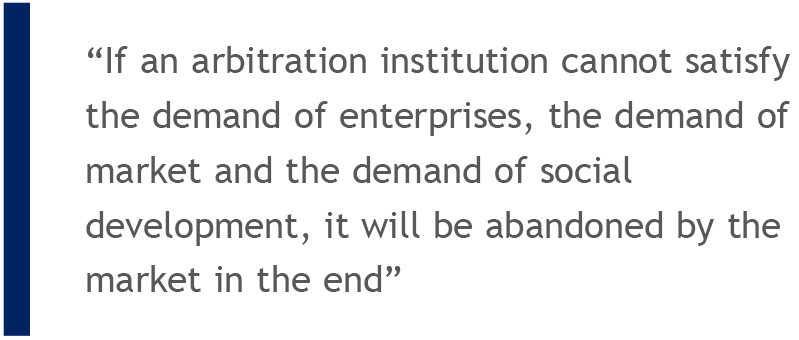 Application of the arbitration rules and the panels of arbitrators
Application of the arbitration rules and the panels of arbitrators
The SCIA is an integral arbitration institution after the merger, and its arbitration rules and the panels of arbitrators will be unified too. The transit period will not be very long. Before the Council revises the arbitration rules and the panels of arbitrators or makes any decision on the application of arbitration rules and the panels of arbitrators, it will be disposed in accordance with the following principle: If the parties have agreed on the “Shenzhen Court of International Arbitration”, the “South China International Economic and Trade Arbitration Commission” or any former name of it, the Arbitration Rules of Shenzhen Court of International Arbitration released in December 2016 and the Panel of Arbitrators of Shenzhen Court of International Arbitration shall be applied, unless otherwise agreed by the parties; if the parties have agreed on “Shenzhen Arbitration Commission”, the Arbitration Rules of Shenzhen Arbitration Commission the Panel of arbitrators of Shenzhen Arbitration Commission shall be applied.
As regards the revision of the arbitration rules and the Panel of Arbitrators, we sincerely welcome the suggestions and advice from the whole society, so as to establish a world-class arbitration platform together.
Service quality
Shenzhen is a city developing rapidly in the boom of its market economy, and the SCIA is an international arbitration institution that sets its foot in Shenzhen and develops on the basis of its services; it would have not enjoyed the trust of the parties from China and throughout the world without high-quality services. After the merger, the total standard of the SCIA’s services must be improved. If there is any deterioration, complaints could be made to the administration or the Council of the SCIA at any time.
The SCIA’s services, standards, vision, influence and credibility will all be improved. The new administration and the whole personnel of the SCIA are very confident about it. But whether we can achieve our goals will be proved in time, under the supervision of our users.
![]()

















